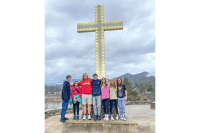The Naturalist's Corner
Endangered Species Act Threatened
A California cowboy is trying to hobble the Endangered Species Act (ESA). Congressman Richard Pombo (R-Calif.), head of the House Resources Committee has herded his Threatened and Endangered Species Recovery Act of 2005 through the US House of Representatives. The act passed, largely along party lines, by a 229 193 vote.
Even the staunchest conservationist would admit that the 30-year old ESA could use some updating. But Pombo doesnÕt want the ESA updated. He simply wants it gone. In fact his bill calls for the ESA to end in 2015 and be replaced with legislation that would please his property-rights, farming and corporate donors.
Half full or half empty
Pombo and his supporters rant that the ESA is ineffective. They point to the fact that since the inception of the ESA only about 15 of the 1,300 species listed have recovered to the point that they have been removed from the list.
That would be like walking into an emergency room and saying, Look, everyone is sick. This hospital must be a failure.Õ said Kieran Suckling in an April 2005 piece in National Geographic News. Suckling, policy director for the Center for Biological Diversity in Tucson, Arizona is co-author of a report on the ESA published in the journal Bioscience in the spring of 2005. That report finds that the longer a species is protected under the ESA, the more likely it is to recover.
On the flip side, only nine species have been declared extinct since the ESA was initiated. This is pretty remarkable considering that by the time most species are listed their numbers are so low that recovery is a decidedly uphill battle.
One hallmark of PomboÕs bill is the elimination of critical habitat. Under the current ESA, critical habitat is required to be designated when a species is listed and is protected from adverse actions by federal agencies.
Related Items
Critical habitat designation has been hard to come by since the Reagan Administration introduced regulations in 1986 that diminished the U.S. Fish and Wildlife ServiceÕs ability to establish critical habitat. However, recent court cases have struck down the 1986 regulations and new critical habitats have been established leading Suckling to note, Our results suggest that if this progress continues, the proportion of species with recovering trends will increase significantly.
Most proponents of the ESA would like to see private landowners brought into the process as partners and encourage some kind of incentive program for those who have endangered species on their property.
Pombo takes this idea to the absurd. It specifies that landowners with development plans are due answers regarding endangered species, from the interior secretary within 180 days. It does allow for one 180-day extension. If the government fails to respond within that time frame, the landowner may proceed with whatever plans he or she might have. If endangered species are found and the government blocks development, the landowner must be compensated Ñ not the fair market value of the property but the fair market value of the proposed development. I can see it now, Well, Your Honor, I was going to build 200 condos and sell them for $2 million apiece.
PomboÕs bill would not even apply to pesticide use for at least five years, protection of threatened species would no longer be mandatory; and the interior secretary, rather than U.S. Fish and Wildlife, would determine what constitutes appropriate scientific data for decision-making under the law. This bill also consolidates enforcement solely in the hands of the Secretary of the Interior instead of Fish and Wildlife and would require that all information used to list or delist a species, designate critical habitat and/or revise recovery plans be duplicated and made available in every state where the species occurs.
While Pombo and his supporters say that the ESA is a failure, a peer-reviewed analysis on the website of the scientific journal Ecology Letters states that more than 50 percent of species listed for 13 years or more have stabilized or are showing improvement.
Man on a mission
This latest attack on the ESA is PomboÕs twelfth since being elected to Congress in 1992. Only one of those efforts passed out of committee. That was in 1996, when Newt Gingrich was House Speaker and according to reports the bill was too controversial, even for Gingrich, and it never made it to the House floor.
But Pombo continued to work to ingrain himself with powerful Republicans in D.C., and it paid off in 2003 when he was appointed chairman of the Resources Committee. According to Matt Weiser, who reports for the Sacramento Bee, Pombo was selected for the chairmanship over seven, more senior Republicans. Weiser posits that the leap-frogging occurred because of PomboÕs close ties with Rep. Don Young of Alaska and an endorsement from Majority Leader Tom Delay.
But all is not happy in Republicanville. Pombo supporters are leery of some Republican senators. Henry Lamb of the right-wing non-profit Environmental Conservation Organization warns readers to beware of Mike Crapo (R-Idaho) who is on the Senate Agriculture Committee. In an opinion piece Lamb wrote, While he [Crapo] works closely with Richard Pombo in the House, Crapo is seen by many to be far too willing to listen, and be influenced, by environmental lobbyists.
And conservationists are looking to Senator Lincoln Chafee (R-R.I.) who is head of the Environment and Public Works Subcommittee on Fisheries, Wildlife and Water and has expressed concerns regarding PomboÕs bill.
Under the cowboy hat
PomboÕs roots run deep and wide in the fertile San Joaquin Valley, where, according to Weiser, his grandfather (a Portuguese immigrant), generated a large family of farmers, ranchers and land barons.
The San Joaquin Valley appears to be as fertile for the imagination as it is for vegetation. Pombo often reflects on how his battle with what he called the eco-federal coalition in a 1996 book Ñ This Land is our Land Ñ began with an attempt by the East Bay Regional Park District to put a trail along land that crossed the family ranch.
Before the book, Pombo was struggling against environmentalists. According to Weiser, he testified before a Senate subcommittee in 1994 that the family ranch was devaluee when the U.S. Fish and Wildlife Service declared portions critical habitat for the endangered San Joaquin kit fox.
ItÕs pretty easy to see how such events could spur a bit of righteous indignation. ThereÕs only one problem neither event happened.
There was a park trail proposed, but it was 20 mileaway, and Pombo finally had to admit on the MacNeil-Lehrer News Hour that he has never been personally affected by any critical habitat designation.
His lack of veracity, however, has not impeded his cash flow. In the last (2004) election cycle, nearly two-thirds of the $1.1 million Pombo received came from agribusiness, energy, developers and property-rights advocates. And Pombo was quick to put that money to work, creating Rich Pac, a political action committee to support his political allies. Pombo sponsors an organization known as the International Foundation for the Conservation of Natural Resources. Weiser writes that this foundation received $130,000 in donations from food giants Monsanto, Sysco and General Mills between 2001-2003, then produced a series of position papers touting the importance of bioengineered food.
According to Vote Pombo Out, a website dedicated to unseating the congressman, Pombo has steered more than a quarter of a million dollars of his campaign contributions to family members and pushed for favorable wind farm legislation without disclosing that his family garners substantial revenue from leasing land for wind farms.
Pombo is a self-avowed conservationist. However the League of Conservation Voters gives him an average score of 8 percent Ñ among the lowest in Congress Ñ over his career.
One expects criticism from the Democratic side of the aisle, but PomboÕs ESA rewrite has some Republican detractors too. Joe DiPeso, policy director for Republicans for Environmental Protection, was quoted by Weiser as stating, His priorities in the areas of energy, public lands and wildlife conservation are completely at odds with the best interests of our nation. I cannot think of a worse person to be chairman of the Resources Committee.
This is one cowboy that needs to be reined in.









